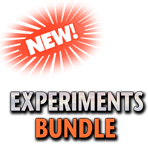
iNSIGHT© is a curriculum supplement for vision science and experimental psychology lab classes. iNSIGHT labs can be divided into two general categories: Interactive Demonstrations and Experiments. Demonstrations illustrate a visual phenomenon and allow students to manipulate the effect. Experiments are real psychophysical procedures (NOT simulations) that generate real data. Each lab is complete with a quick-start guide, detailed instructions, background information, and one or more guided exercises.
SUPPORT MATERIALS
E-mail Tech Support
for iNSIGHT Apps
Physics Lab Simulations
Vision Science Lab Simulations
|

|
|||||
|
COLOR MIXING Demonstration This is a demonstration of additive and subtractive color mixing, or the mixing of colored lights and colored pigments. The proportion of the primary colors in a color mixture can be adjusted, and the position of a given color mixture can be plotted in a 3D color space. |
FORM AND MOTION Demonstration The visual system is well suited to extracting information about the structure and form of objects on the basis of motion. In this demonstration, randomly-positioned dots, which contain no apparent structure when stationary, are animated to produce vivid perceptions of three-dimensional structures. |
ILLUSIONS AND AFTEREFFECTS Demonstration Illusions are fun and interesting to view, but more importantly they provide insights into how our visual system works. By discovering ways in which the visual system can be “fooled,” we can learn something about the way we see. Some effects require red-green or red-blue glasses. |
SPATIAL VISION Demonstration A process called Fourier analysis can be used to mathematically break down any image into a number of basic components. By manipulating these components and then reassembling them, a variety of visual effects can be achieved. This process demonstrates how our visual system analyzes images, and how different types of visual problems can affect our perception of shapes and edges. |
||
|
COLOR VISION TEST Demonstration This is an adaptation of a common clinical test for color vision disorders. Students arrange colored discs then analyze the results to identify color vision deficiencies. |
STEREOGRAMS Demonstration Stereograms create an illusion of depth because slightly different images are presented to each eye. They simulate the real-world situation in which each eye views the world from a slightly different position. Different types of stereograms, including random-element, line, and stereo photographs are presented. Requires red-green or red-blue glasses. |
RECEPTIVE FIELD MAPPING Demonstration This is a demonstration of mapping the receptive fields of neurons in the visual system. Students play the role of a vision scientist trying to find the location and best stimulus for getting responses from individual visual cells. |
MACH BANDS Demonstration Mach bands are an illusion produced by the communication between neighboring cells in the retina. Because nearby cells can inhibit each others’ responses (lateral inhibition), our perception of edges is enhanced. Learn how lateral inhibition can enhance edge perception, and create illusions that demonstrate Mach band effects. |
||
|
|||||
|
SCALING VISION Experiment A magnitude estimation procedure is used to measure our perception of the magnitude of different types of stimuli. Students make predictions based on conflicting theories, and test their results against their predictions. A number of variables known to influence the results of a magnitude estimation procedure can be manipulated. |
FEATURE ANALYSIS Experiment A reaction-time procedure is used together with a visual search task to measure the speed of cognitive operations (visual and other “thought” processes). Some types of visual information are processed in parallel, while other types require focused attention and are processed serially. This experiment demonstrates the types of visual features that are processed serially and in parallel. |
SIGNAL DETECTION Experiment A rating scale procedure is used with different stimuli to demonstrate basic concepts of signal detection theory — response criterion, d-prime, and ROC curves. |
GLOBAL PRECEDENCE Experiment A reaction-time procedure is used to measure different types of information processing by the visual system. This procedure demonstrates how the speed and sequence of visual processing can be measured, and shows the relative importance of different attributes of visual images (we see the forest before the trees). |
||
MEASURING ILLUSIONS Experiment A Yes-No procedure combined with the method of limits are used to measure the size of different visual illusions. This provides the student with the tools to experimentally determine the features of the stimulus that produce the illusion. |
DEPTH PERCEPTION Experiment A magnitude estimation procedure is used to measure the apparent distance between a reference point and a figure that appears to be either in front of or behind it. The results illustrate the relation between the difference between the two eyes’ views and the perception of depth. Requires red-green or red-blue glasses. |
||||
|
CONTRAST SENSITIVITY Experiment Method of adjustment and forced-choice procedures are used to measure the contrast sensitivity function. “Common sense” suggests that it is easier to see “big things” than it is to see “small things.” This experiment demonstrates that common sense is not always correct. |
|||||
| |||||
 All eight iNSIGHT Interactive Demo apps for one low price!
|
 All seven iNSIGHT Experiments apps for one low price!
|
||||

Copyright © 2025 by Polyhedron Learning Media, Inc. All rights reserved.